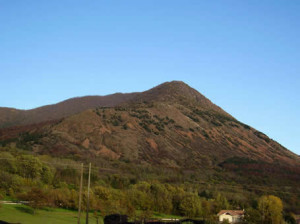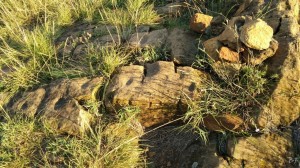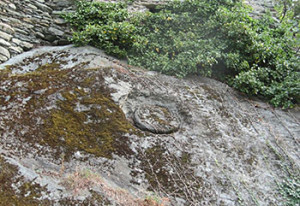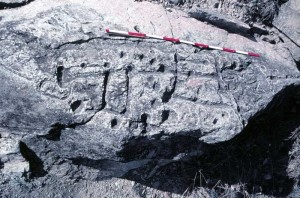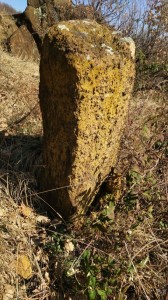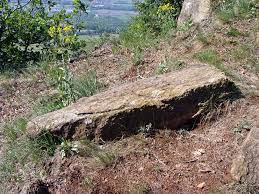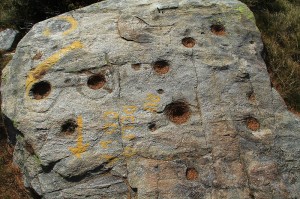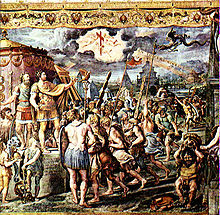The constellation of the Great Bear or Big Dipper plays a role of great importance in Western and Eastern esoteric traditions, as does the figure of the Dragon. In this article we see how Dragons and Stars are also present on the magic mount Musinè, the mountain located at the mouth of the Susa valley, in front of the Sacra di San Michele.
Mount Musinè is well-known in the geological world for being one of the most important outcrops of the Earth’s mantle. It is made up of ultra-basic rocks (olivine peridotites, pyroxene, spinel) almost spared from Alpine metamorphic transformations. The composition of these rocks is rich in iron and magnesium minerals, which, in excess, lead to a considerable lowering of the level of natural fertility, so altering the nutritional potential of plants.
This explains, therefore, how the mountain has always been rather barren, with little shrub vegetation and some hints of oak wood often devastated by fires. This is how this foothill alpine strip looks going north, but the figure of mount Musinè as a lonely sentinel at the entrance to the Susa valley has always been talked about since ancient times.
However, it should also be taken into consideration that its rocks are little altered, spared from the metamorphic action of neotectonics, thus giving the mountain, together with its isolated position, a volcanic aspect. The abundance of ferrous rocks lends particular qualities to the soil, because undoubtedly their large mass produces an alteration of the geomagnetic field surrounding the mountain, a prerequisite for the creation of the so-called “terrestrial acupuncture” perhaps used for sacred ceremonials in megalithic sites such as Stonehenge and Avebury. These field anomalies can certainly affect the working of many instruments, from the most sophisticated, as the electronic ones, to the most simple ones such as compasses.
This geobiological analysis therefore leads us to understand how the Fire element is inextricably linked to the stories and legends that are handed down on Mount Musinè, as well as science fiction hypotheses, the most famous of which is based on the discovery of a particular obelisk that acquired fame worldwide thanks to a book by Peter Kolosimo entitled “Spaceships on prehistory”. On its surface some crosses appear, up to the left a circle with a dot in the center and two semicircles cut in the lower part.
The history of the mountain has always been bound to sacred rites and ancient traditions: archaeological investigations have led to the discovery of traces of settlements dating back to the second millennium BC, with numerous prehistoric findings attached. On Musiné, several traces of megaliths can be found which confirm the sacredness attributed to the mountain, as in the case of the cupels carved into the rock, easily visible during the climbing. They are typical of the ceremonial areas of the ancient Druids but along with them you can also notice some recent signs, proof of the fact that the place is still used for pagan ceremonies. More important and significant are the menhirs of considerable size on which prehistoric graffiti with drawings attributable to star maps are engraved.
Numerous legends always refer to the same type of energy, whose physical origin we have explained, from chariots of fire to the inevitable dragon / snake, and then all the representations of the Universe, from the Sun to the Stars.
The Dragon / snake also seems to appear next to the solar symbol: both on Musinè, where we see it engraved near the depiction of the star and tooled under what appears to be a star cluster, and near Caprie, again in the Susa valley, where a stone blade overhung by solar signs overlooka 150 meter cliff.
In addition to solar representations, on Musinè we can find menhirs, stones which could be prehistoric sacrificial areas, such as the perfectly squared trapezoidal monolith found just below the summit.
The ritual fires mentioned above could have been generated by the lighting of resins and animal fats in the cupels (engravings of small cups) which abound on the mountain, between 400 and 900 meters above sea level, as if to repeat on Earth a celestial pattern related to the geometry of constellations. According to some authors, it is possible to reconstruct a large part of the Boreal Sky from the disposition of the cupels.
Also in La Ferrassiè (Charente) an engraving depicting the stars of the Big Dipper was found, similar to the one discovered on Musinè and shown below.
Mount Musinè with its mysteries stands as a further testimony of the connections between micro and macrocosm, reminding us once again that under a single sky the Actors (namely the cosmic forces and the telluric forces) are always the same, and they return cyclically to present themselves to the keen eyes of spiritual seekers: the wheel of Hamlet’s Mill turns and with it the axis of time and space.
In the local space at the mouth of the Susa valley between the Sacra and Mount Musinè, battles take place which decide the fate of Western history: Maxentius and Constantine (Pagans against Christians) first and Charlemagne and Adelchi (Franks against Lombards) then.
The Cross that appeared to Constantine “in a dream” was the constellation of the Northern Cross or Swan which the night before the battle was visible just above Mount Musinè, thus indicating the right place to win (In hoc signo vinces), a beautiful example of a Earth-Heaven connection.
In this regard, the proximity of the Musinè with the Saint Michael’s line, which passes a short distance on Mount Pirchiriano, where the Sacra of the same name was built, should certainly not be overlooked. The particular origins of the site are both geomorphological and mythological: on the one hand, two mountains that control the mouth of the Susa valley and the Via Francigena facing each other, on the other hand the references to the Dragon that appear both for San Michele and for Musinè. It is therefore an obvious link to understand the powerful contrast of chthonic energies (telluric / underworld) and celestial ones (spiritual / cosmic / supere) which seem to mark an earthly place of particular importance from the astral.
